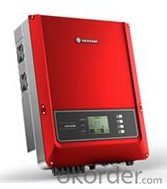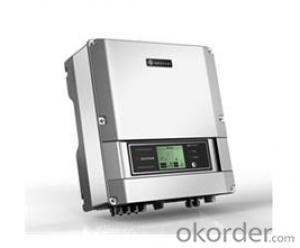Solar Inverter On-Grid Type Solartec Central 500
- Loading Port:
- Shanghai
- Payment Terms:
- TT OR LC
- Min Order Qty:
- 10 unit
- Supply Capability:
- 1000 unit/month
OKorder Service Pledge
OKorder Financial Service
You Might Also Like
3. High effiency and low noise
.2. Can used out of doors
The photovoltaic grid-connected inverters in the Solartec Central 250/500 series are applicable to rooftop projects and power plant projects. The nominal output powers of Solartec Central 250 and Solartec Central 500 are 250 kW and 500 kW respectively.
1. Powered by DC current
This series has the Siemens core inverter module, an advanced MPPT algorithm and advanced circuit topology. They have a high conversion efficiency. They have a fast and highly accurate control chip, and have the functions of reactive power compensation, harmonic controlling, overcurrent protection, overvoltage protection, temperature protection, active and passive islanding detection and low-voltage ride through. Additionally, they support optical fiber remote monitoring and have reached European certification standards, including Germany’s.

Product Advantages:
1. Powered by DC current
2. Can used out of doors
3. High effiency and low noise
FAQ:
What is your payment terms?
We accept T/T payment, normally we need 20% T/T in advance, 80% payed before shipment.
What is your packing system?
We put the sistem in the wooden box.
Can you do OEM service?
Yes we can, but we need to do it with a certain order quantity.
- Q:Can a solar inverter be used with a solar-powered electric fence system?
- Yes, a solar inverter can be used with a solar-powered electric fence system. The solar inverter will convert the direct current (DC) power generated by the solar panels into alternating current (AC) power, which can then be used to power the electric fence system. This ensures that the fence receives a constant and reliable power supply from the solar panels.
- Q:How do you connect a solar inverter to solar panels?
- To connect a solar inverter to solar panels, you need to follow a few steps. First, ensure that the solar panels are properly installed and positioned to receive maximum sunlight. Then, connect the positive and negative terminals of the solar panels to the corresponding terminals on the solar inverter. Make sure to use appropriate cables and connectors for a secure connection. Once the connections are made, the solar inverter will convert the solar energy generated by the panels into usable electricity for your home or business.
- Q:What is the role of a solar inverter in grid management and stability?
- The role of a solar inverter in grid management and stability is crucial in integrating solar power into the existing electrical grid system. Solar inverters are responsible for converting the direct current (DC) electricity generated by solar panels into alternating current (AC) electricity that can be used by homes and businesses or fed back into the grid. In terms of grid management, solar inverters play a vital role in maintaining the stability and reliability of the electrical grid. They provide grid support functions such as voltage regulation, frequency control, and reactive power compensation. By monitoring the grid conditions and adjusting the output of solar power accordingly, inverters help to balance the supply and demand of electricity in real-time, ensuring grid stability. Solar inverters also contribute to grid stability by improving power quality. They actively filter out harmonics, voltage fluctuations, and other electrical disturbances that can be caused by the intermittent nature of solar power generation. This ensures that the electricity generated by solar panels is of high quality and does not introduce any disruptions or damage to the electrical grid. Furthermore, solar inverters enable the seamless integration of solar power into the grid, allowing excess energy to be fed back into the system. This is known as net metering or feed-in tariff programs, where solar energy producers can receive compensation for the surplus electricity they produce. With the help of inverters, the generated solar energy can be efficiently transferred to the grid, reducing the reliance on traditional fossil fuel-based power generation and promoting renewable energy integration. Overall, the role of a solar inverter in grid management and stability is to ensure the smooth integration and optimal utilization of solar power, while maintaining the stability, reliability, and quality of the electrical grid. It acts as a bridge between solar energy producers and the grid, facilitating the efficient and sustainable integration of renewable energy sources into the existing power infrastructure.
- Q:Can a solar inverter be used in areas with high humidity and salt air exposure?
- Yes, a solar inverter can be used in areas with high humidity and salt air exposure. However, it is important to choose a solar inverter that is specifically designed for such conditions, as these factors can potentially impact the performance and lifespan of the inverter. It is advisable to consult with a professional to ensure the selection of a suitable solar inverter for areas with high humidity and salt air exposure.
- Q:Can a solar inverter be used with solar-powered outdoor lighting?
- Yes, a solar inverter can be used with solar-powered outdoor lighting. A solar inverter converts the direct current (DC) generated by the solar panels into alternating current (AC) that is required to power the outdoor lighting fixtures. This allows for efficient and reliable operation of the solar-powered lighting system.
- Q:Three-phase photovoltaic inverter grid, the use of phase-locked loop is what?
- Grid-connected inverter can be operated locally through the LCD screen, or through remote monitoring with dedicated monitoring software.
- Q:What is the maximum voltage input for a solar inverter?
- The maximum voltage input for a solar inverter typically depends on the specific model and manufacturer. However, in general, it ranges from around 600 to 1000 volts, with some higher-end models able to handle higher voltages.
- Q:What is the role of reactive power control in a solar inverter?
- The role of reactive power control in a solar inverter is to manage and regulate the flow of reactive power in the electrical system. It helps to maintain a stable voltage level, improve power factor, and ensure efficient operation of the solar inverter. By controlling reactive power, the inverter can mitigate voltage fluctuations and provide optimal power quality, making the system more reliable and compliant with grid requirements.
- Q:What are the safety considerations when installing a solar inverter?
- When installing a solar inverter, there are several important safety considerations to keep in mind. Firstly, it is crucial to ensure that the power supply to the inverter is completely disconnected before beginning the installation process. This helps to prevent any electrical shocks or accidents. Additionally, it is important to follow the manufacturer's instructions and guidelines precisely to ensure a safe installation. Another key safety consideration is to make sure that the inverter is properly grounded to prevent the risk of electrical faults or fires. Finally, it is advisable to work with a qualified and experienced electrician to ensure that the installation is done correctly and in compliance with local electrical codes and regulations.
- Q:What is the power factor correction capability of a solar inverter?
- The power factor correction capability of a solar inverter refers to its ability to correct any power factor issues in the electrical system it is connected to. A solar inverter typically aims to achieve a power factor as close to 1 as possible, which indicates a balanced and efficient use of electrical power. By actively monitoring and adjusting the power factor, a solar inverter ensures that the energy generated from the solar panels is effectively utilized and does not cause any unnecessary strain on the electrical grid.
1. Manufacturer Overview |
|
|---|---|
| Location | |
| Year Established | |
| Annual Output Value | |
| Main Markets | |
| Company Certifications | |
2. Manufacturer Certificates |
|
|---|---|
| a) Certification Name | |
| Range | |
| Reference | |
| Validity Period | |
3. Manufacturer Capability |
|
|---|---|
| a)Trade Capacity | |
| Nearest Port | |
| Export Percentage | |
| No.of Employees in Trade Department | |
| Language Spoken: | |
| b)Factory Information | |
| Factory Size: | |
| No. of Production Lines | |
| Contract Manufacturing | |
| Product Price Range | |
Send your message to us
Solar Inverter On-Grid Type Solartec Central 500
- Loading Port:
- Shanghai
- Payment Terms:
- TT OR LC
- Min Order Qty:
- 10 unit
- Supply Capability:
- 1000 unit/month
OKorder Service Pledge
OKorder Financial Service
Similar products
New products
Hot products
Hot Searches
Related keywords






























